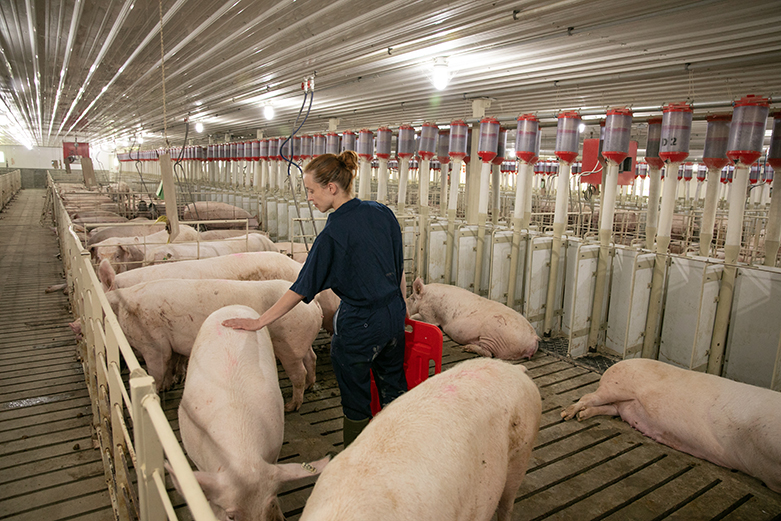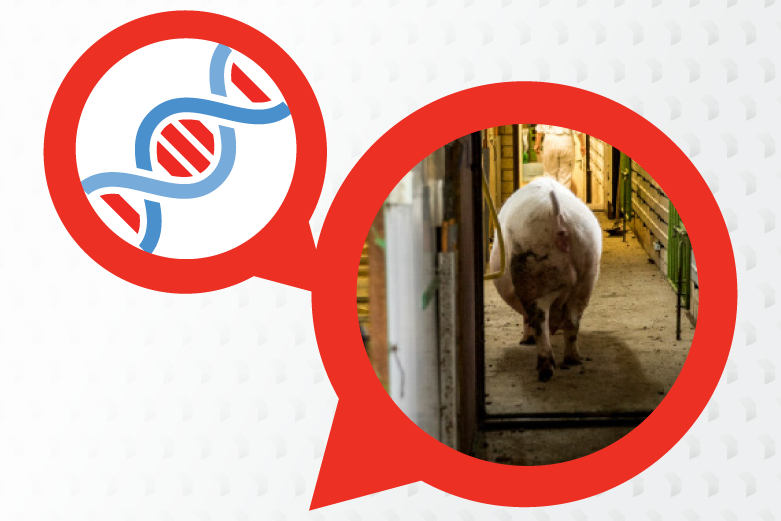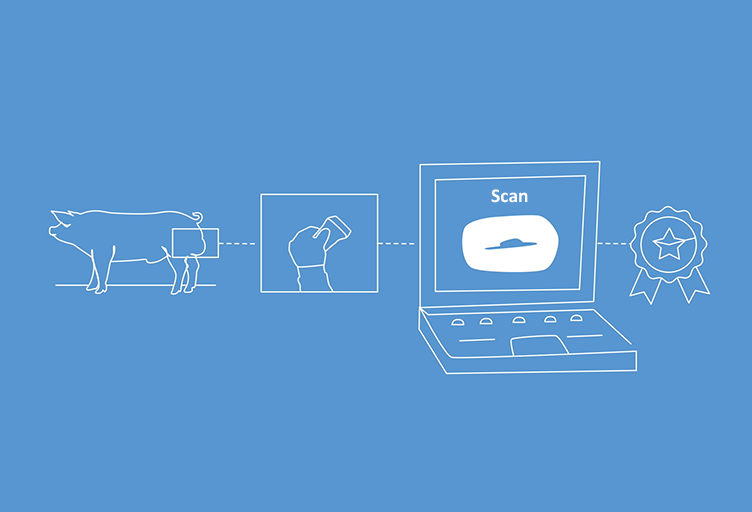The domestication from the wild boar to the domestic pig centuries ago was the onset of genetic improvement in pigs. Then afterwards, different breeds and lines were developed. At the start of the 20th century herd books in Europe started to maintain pedigree records and advocated selection on physical appearance. This continued into the 1950’s when additional gains were achieved on backfat reduction and growth rate improvement through measuring these traits on individual animals. At the same time, physical appearance was still very important. As data recording methods and genetic evaluation methods evolved, breeding goals changed. At the same time, pig breeding moved from genetic improvement through open herd books towards breeding specific lines by individual breeding companies.
PIC: Where it all began – A small group of Oxford farmers …
PIC started in 1962 in the UK as a small group of Oxford farmers and scientists that wanted to create the highest quality pig on the market by combining the latest science, pig biological under-standing, and pork production economics. Today, the name of our flagship sow still pays tribute to the founder’s belief in science and innovation and recognises the important research collaborations early in PIC. The name Camborough is a combination of the words ‘Cambridge’ and ‘Edinburgh’ which were the two universities that the farmers collaborated with at the start of PIC.

The next real leap in the science of selection was the introduction of Best Linear Unbiased Prediction (BLUP) models to estimate breeding values in 1991 and this was a real game changer. With BLUP it became possible to estimate breeding values using information on relatives while correcting phenotypes for systematic influences and then combine this into index selection.
Breeding objectives evolve over time
The introduction of BLUP (Best Linear Unbiased Prediction) resulted in huge changes in production. For instance, average production in Europe has changed from 10 total pigs per litter in 2000 up to 14 born alive pigs per litter in 2018 (source: InterPIG Report). Growth rates have improved from 580 g/day in 1981 to 829 g/day finishing daily liveweight gain in 2018 (source: InterPIG Report).
Breeding goals have changed because of changing economics, as well as changes in relevance and measurability of traits. As we move into the future increasingly external market forces will also play a role in the breeding goal. Today traits, with low heritability that require extensive data re-cording, become more and more important. Over time breeding goals have changed from sole focus on physical appearance, feed efficiency, lean % and growth to today’s breeding goal with focus on lifetime reproduction, robustness of pigs, and meat quality. However, feed efficiency and lean % remain included due to its economic impact. Nevertheless, we believe that today’s breeding objectives are presumably not tomorrows breeding goals. The industry is continuing to evolve and so will breeding goals. Our focus will remain on identifying relevant new traits, research them, and implement tools to measure effectively.

After defining the breeding goal measuring the right traits to improve the goal is key. Within every genetic improvement program, elite genetic farms are producing boars and gilts. On these farms detailed data capture is performed which includes the performance potential of each individual pig. These genetic farms have a high health status, higher amounts of labor per pig, are generally located in temperate climates and animals are purebreds targeted for selection purposes.
Exceptional performance in commercial environment is key
The environment in genetic farms is different from commercial production systems where focus is on low cost production and health status is often compromised by diseases (PRRSv, PED, APP, Mycoplasma etc.). Additionally, the commercial pig is a crossbred pig, typically the product of an F1 female and a terminal boar. Studies have shown that animals that perform best in a genetic environment might not always be the best animals in a commercial environment and might even re-rank. However, pigs must perform in a range of environments from the US to Brazil to Spain, UK, Germany or China.

To select pigs that perform best in commercial systems, PIC introduced its Genetic Nucleus Cross-bred program (GNX-bred program) in 2003 and has been using it ever since. This program allows PIC to test elite genetics in commercial environments. Young elite boars are used to produce crossbred pigs in real-world production facilities to measure and select for robust, predictable commercial performance. The sow farms and finishers are located across six continents, and located in pig-dense areas, having conventional health and typical commercial production environments.
Genomics – Opening up exciting opportunities
After the introduction of BLUP in 1991 the next major milestone in animal breeding and selection was the introduction of Relationship-Based Genomic Selection (RBGS) into PIC’s genetic program in 2013. This new technology has increased the traditional rate of genetic progress by over 35% per year for all traits, product lines and commercial products. This translates to a profit improvement of £ 2.70 to £ 3.10 per pig per year. RBGS replaced the assumed pedigree-based relationship between animals in the traditional BLUP genetic evaluation by the actual genomic-based relationship between animals and so increasing the accuracy of how data of family members is considered within the genetic evaluation.
In PIC’s Elite farms at the top of the pyramid, they have seen significant advancement in traits that directly impact the efficiency, throughput and robustness of pork production. This is a direct result of the introduction of RBGS and other on-going investments in technology.

A specific example of this additional value is the impressive change in both total born and average piglet birth weight. PIC has been measuring individual piglet birth weight for several years and has incorporated it into the selection process while implementing RBGS. As a result, the PIC genetic farms have been able to realize a continual improvement in total born while simultaneously, direct selection on individual piglet birth weight has led to an increase of birth weights during the same period. Total born is a critical measure of success on a sow farm, but if birth weight and survivability of piglets are low, the value of increased total born is minimal.
Now that birth weight is also increasing, these additional pigs are more viable and will increase the producers’ productivity and profit potential. Linked to the improvement in birth weight, pre-wean survival has seen a sharp improvement of 0,8 percentage points average per year for the last five years. Even though these improvements relate directly to the profit potential for the producer the additional effect on ease of management, improved animal welfare and less workload should not be neglected.
Maternal improvements at the genetic farm level take approximately two to three years to disseminate through a multiplication system to the commercial level. Now, approximately six years after full implementation of RGBS, customers are seeing the impact from this improved rate of gain at their commercial sow farms. The full benefits of these genetic changes in PIC lines are being observed as commercial finisher pigs are reaching market. PIC maintains a customer data-base of commercial performance data reproductive results and growing pig performance data in North and South America as well as from Europe and Russia.
The database includes reproductive results from over 1 million sows and performance data of 7.1 million growing pigs. The performance data are showing strong year-over-year gains. The phenotypic trends of traits ranging from total born to feed conversion to average daily gain are showing trends equal to or greater than the predicted genetic trend.
Sequencing the full pig genome
![]() The next step in the long tradition of innovation in pig breeding is the utilization of full DNA sequence information. The genome of the domestic pig has around three billion nucleotides, similar in size to humans. With the current genomic technology roughly 50,000 locations on the pig genome are captured. That’s just 0.002 % of the entire genome. With full sequence information available, PIC will be able to improve the understanding of the specific genotypes, and underlying biology, that impacts phenotypic traits. This will accelerate the rate of genetic improvement. Per today ca. 8,000 animals of all major PIC lines have been fully sequenced. Genome sequence in-formation can help to improve the rate of genetic improvement by optimizing the genomic based relationships between animals. Other possibilities include identifying genes that can impact resistance to diseases that challenge the pork industry.
The next step in the long tradition of innovation in pig breeding is the utilization of full DNA sequence information. The genome of the domestic pig has around three billion nucleotides, similar in size to humans. With the current genomic technology roughly 50,000 locations on the pig genome are captured. That’s just 0.002 % of the entire genome. With full sequence information available, PIC will be able to improve the understanding of the specific genotypes, and underlying biology, that impacts phenotypic traits. This will accelerate the rate of genetic improvement. Per today ca. 8,000 animals of all major PIC lines have been fully sequenced. Genome sequence in-formation can help to improve the rate of genetic improvement by optimizing the genomic based relationships between animals. Other possibilities include identifying genes that can impact resistance to diseases that challenge the pork industry.
Another advancement that will allow acceleration of genetic improvement are gene-editing techniques. Genus plc announced in 2015 that in collaboration with the University of Missouri it was able to produce a PRRSv-resistant pig. The PRRSv-resistant pig has been developed using gene-editing technology and does not contain any foreign DNA or any new combination of genetic material. Once ready for market this will save millions of pigs from dying from this disease.
PIC leads with innovation
1950s
Study group of farmers meets in Oxfordshire, England, to discuss improving pigs.
1962
Pig Improvement Company (PIC) is founded.
1964
Minimal disease concept established.
First Camborough gilts delivered.
1983
PIC is first to demonstrate selection for prolificacy.
1986
Acquisition of Kleen Leen Genetics.
Recording and analysis system, Pigtales, is implemented.
1990
PIC is first to use DNA probe to test for halothane gene.
1991
BLUP is implemented for breeding value estimation.
1995
PIC acquires NPD.
1998
PICTraqTM introduced.
2003
Sireline GNXbred introduced.
2009
Development of new genetic nucleus (APEX).
Research with the first porcine SNP genotyping chip.
2013
PIC acquires Génétiporc.
2013
PIC implements relationship-based genomics, increasing rate of gain by over 35%.
2015
First gene-edited pig showing PRRS-resistance is announced.
2017
Hermitage acquisition of genetic rights and strategic partnership.
2018
Møllevang partnership.
2020
PIC and Hermitage establish Global Elite Farm herd in Ireland.
Clearly, genetic improvement of the pig has rapidly progressed over the past 50 years moving through various levels of technology utilization and this trend only looks to increase. The next window of time promises to be more exciting as new technologies evolve that benefit global food production and specifically European farmers.
The authors
Saskia Bloemhof-Abma, Ph.D. – is PIC’s Technical Communications Manager. Her continuous focus is to exchange technical information in an easy to understand manner that helps PIC’s customers to become the most successful producers globally.
Craig R. G. Lewis, Ph.D. – is part of PIC’s Product Development Team. He coordinates Genetic Services across Europa including Russia and Africa.




